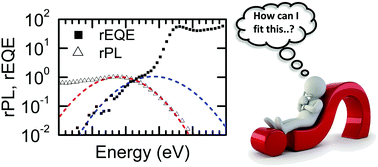当前位置:
X-MOL 学术
›
Mater. Horiz.
›
论文详情
Our official English website, www.x-mol.net, welcomes your feedback! (Note: you will need to create a separate account there.)
How to interpret absorption and fluorescence spectra of charge transfer states in an organic solar cell†
Materials Horizons ( IF 13.3 ) Pub Date : 2018-06-27 00:00:00 , DOI: 10.1039/c8mh00564h Frank-Julian Kahle 1, 2, 3, 4 , Alexander Rudnick 1, 2, 3, 4 , Heinz Bässler 2, 3, 4, 5 , Anna Köhler 1, 2, 3, 4, 5
Materials Horizons ( IF 13.3 ) Pub Date : 2018-06-27 00:00:00 , DOI: 10.1039/c8mh00564h Frank-Julian Kahle 1, 2, 3, 4 , Alexander Rudnick 1, 2, 3, 4 , Heinz Bässler 2, 3, 4, 5 , Anna Köhler 1, 2, 3, 4, 5
Affiliation

|
The aim of the present work is to identify the appropriate framework for analyzing photoluminescence and photocurrent (EQE) spectra of charge transfer (CT) states in donor–acceptor blends used as active materials for organic solar cells. It was stimulated by the work of Vandewal et al. (J. Am. Chem. Soc., 2017, 139(4), 1699–1704) who analyzed EQE spectra of CT states of a series of blend systems in terms of Marcus theory assuming that, first, the spectral shape reflects the reorganization energy of the donor upon ionization and, second, that disorder effects are unimportant. To test this assumption we applied gated photoluminescence (PL) spectroscopy within a temperature range from 5 to 295 K combined with EQE as well as electroluminescence (EL) experiments on 1 : 1 Me-LPPP : PCBM blends by weight. We find that the PL spectra are virtually temperature independent and the temporal decay of the emission features a power law with an exponent close to −3/2 as Hong and Noolandi predicted for distributed geminately bound electron-holes pairs. The EL spectrum reveals a red-shift by 100 meV relative to the PL spectrum. The results are inconsistent with both Marcus’ electron transfer theory and the original Marcus–Levich–Jortner (MLJ) theory, and they prove that disorder effects are crucial. Both PL and EQE spectra can be rationalized in terms of the classic Franck–Condon picture of electronic transitions that couple to intra-molecular vibrations as well as low frequency modes of the donor–acceptor pair that forms the CT state.
中文翻译:

如何解释有机太阳能电池中电荷转移态的吸收光谱和荧光光谱†
本工作的目的是确定用于分析供体-受体混合物中用作有机太阳能电池活性材料的电荷转移(CT)状态的光致发光和光电流(EQE)光谱的适当框架。Vandewal等人的工作激发了这一点。(J.Am.Chem.Soc。,2017,139(4),1699–1704)根据马库斯理论分析了一系列共混体系的CT状态的EQE谱,假设首先,谱的形状反映了电离时供体的重组能,其次,该无序效应不重要。为了测试该假设,我们在5到295 K的温度范围内应用了门控光致发光(PL)光谱与EQE结合,并对重量比为1:1的Me-LPPP:PCBM混合物进行了电致发光(EL)实验。我们发现PL光谱实际上与温度无关,并且发射的时间衰减具有幂律,其幂指数接近-3/2,这是Hong和Noolandi预测的成对分布的束缚电子-空穴对的结果。EL光谱显示相对于PL光谱有100 meV的红移。结果与马库斯的电子转移理论和原始的马库斯-莱维奇-乔特纳(MLJ)理论都不一致,并且它们证明无序效应至关重要。PL和EQE光谱都可以根据经典的电子跃迁的Franck-Condon图进行合理化,电子跃迁与分子内的振动以及形成CT状态的供体-受体对的低频模式耦合。
更新日期:2018-06-27
中文翻译:

如何解释有机太阳能电池中电荷转移态的吸收光谱和荧光光谱†
本工作的目的是确定用于分析供体-受体混合物中用作有机太阳能电池活性材料的电荷转移(CT)状态的光致发光和光电流(EQE)光谱的适当框架。Vandewal等人的工作激发了这一点。(J.Am.Chem.Soc。,2017,139(4),1699–1704)根据马库斯理论分析了一系列共混体系的CT状态的EQE谱,假设首先,谱的形状反映了电离时供体的重组能,其次,该无序效应不重要。为了测试该假设,我们在5到295 K的温度范围内应用了门控光致发光(PL)光谱与EQE结合,并对重量比为1:1的Me-LPPP:PCBM混合物进行了电致发光(EL)实验。我们发现PL光谱实际上与温度无关,并且发射的时间衰减具有幂律,其幂指数接近-3/2,这是Hong和Noolandi预测的成对分布的束缚电子-空穴对的结果。EL光谱显示相对于PL光谱有100 meV的红移。结果与马库斯的电子转移理论和原始的马库斯-莱维奇-乔特纳(MLJ)理论都不一致,并且它们证明无序效应至关重要。PL和EQE光谱都可以根据经典的电子跃迁的Franck-Condon图进行合理化,电子跃迁与分子内的振动以及形成CT状态的供体-受体对的低频模式耦合。


























 京公网安备 11010802027423号
京公网安备 11010802027423号